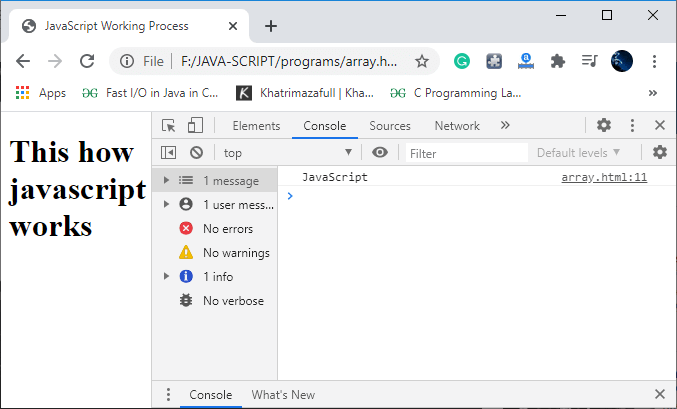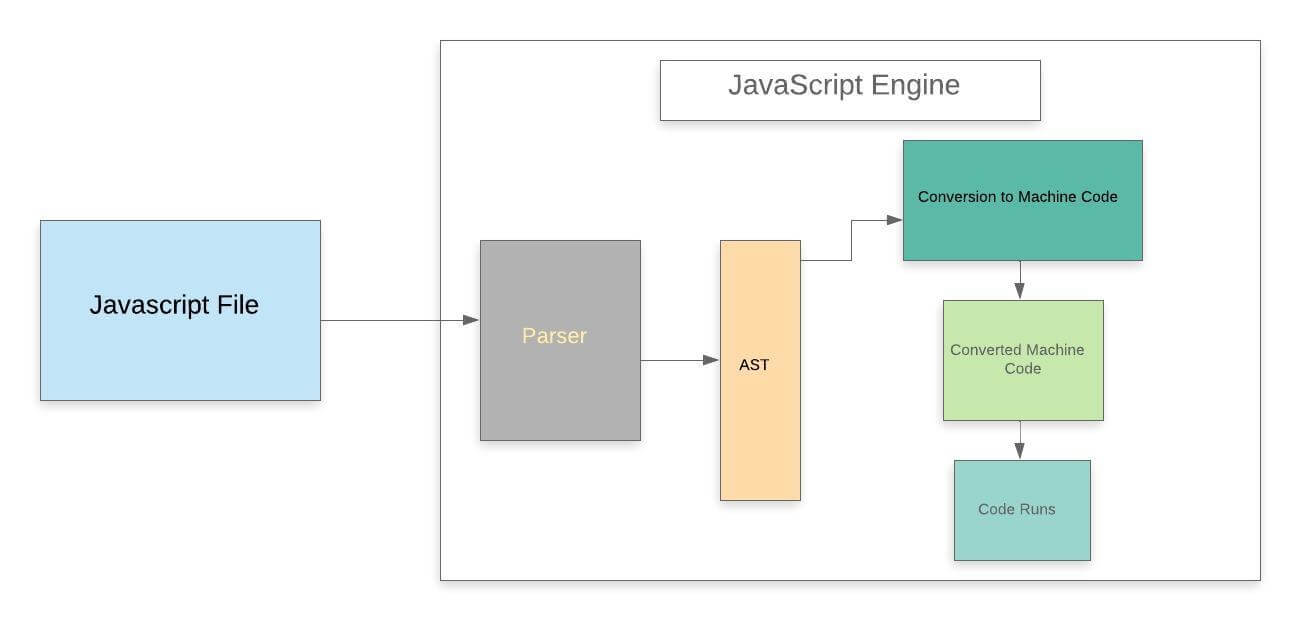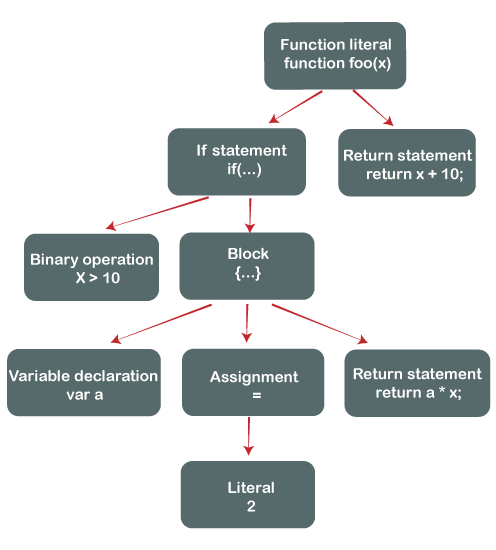-
JavaScript Tutorial
JavaScript Basics
- js-comment
- js-variable
- js-global-variable
- js-data-types
- js-operators
- js-if-statement
- js-switch
- js-loop
- js-function
JavaScript Objects
JavaScript BOM
JavaScript DOM
- 5)-document-object
- getelementbyid
- getelementsbyclassname()
- getelementsbyname
- getelementsbytagname
- js-innerhtml-property
- js-innertext-property
JavaScript Validation
JavaScript OOPs
- js-class
- js-object
- js-prototype
- js-constructor-method
- js-static-method
- js-encapsulation
- js-inheritance
- js-polymorphism
- js-abstraction
JavaScript Cookies
JavaScript Events
- javascript-events
- javascript-addeventlistener()
- js-onclick-event
- js-dblclick-event
- js-onload-event
- js-onresize-event
Exception Handling
JavaScript Misc
- js-this-keyword
- js-debugging
- js-hoisting
- js-strict-mode
- javascript-promise
- js-compare-dates
- javascript-array.length
- javascript-alert()
- javascript-eval()-function
- javascript-closest()
- javascript-continue-statement
- js-getattribute()-method
- js-hide-elements
- javascript-prompt()
- removeattribute()-method
- javascript-reset
- javascript-return
- js-string-split()
- js-typeof-operator
- js-ternary-operator
- js-reload()-method
- js-setattribute()-method
- js-setinterval()-method
- js-settimeout()-method
- js-string-includes()-method
- calculate-current-week-number-in-javascript
- calculate-days-between-two-dates-in-javascript
- javascript-string-trim()
- javascript-timer
- remove-elements-from-array
- javascript-localstorage
- javascript-offsetheight
- confirm-password-validation
- static-vs-const
- how-to-convert-comma-separated-string-into-an-array-in-javascript
- calculate-age-using-javascript
- javascript-label-statement
- javascript-string-with-quotes
- how-to-create-dropdown-list-using-javascript
- how-to-disable-radio-button-using-javascript
JavaScript Advance
- js-typedarray
- js-set
- js-map
- js-weakset
- js-weakmap
- javascript-callback
- javascript-closures
- javascript-date-difference
- javascript-date-format
- js-date-parse()-method
- javascript-defer
- javascript-redirect
- javascript-scope
- javascript-scroll
- javascript-sleep
- javascript-void
- javascript-form
Differences
Questions
- how-to-add-javascript-to-html
- how-to-enable-javascript-in-my-browser
- difference-between-java-and-javascript
- how-to-call-javascript-function-in-html
- how-to-write-a-function-in-javascript
- is-javascript-case-sensitive
- how-does-javascript-work
- how-to-debug-javascript
- how-to-enable-javascript-on-android
- what-is-a-promise-in-javascript
- what-is-hoisting-in-javascript
- what-is-vanilla-javascript
- how-to-add-a-class-to-an-element-using-javascript
- how-to-calculate-the-perimeter-and-area-of-a-circle-using-javascript
- how-to-create-an-image-map-in-javascript
- how-to-find-factorial-of-a-number-in-javascript
- how-to-get-the-value-of-pi-using-javascript
- how-to-make-a-text-italic-using-javascript
- what-are-the-uses-of-javascript
- how-to-get-all-checked-checkbox-value-in-javascript
- how-to-open-json-file
- random-image-generator-in-javascript
- how-to-add-object-in-array-using-javascript
- javascript-window-open-method
- javascript-window-close-method
- how-to-check-a-radio-button-using-javascript
- javascript-const
- javascript-function-to-check-array-is-empty-or-not
- javascript-multi-line-string
- javascript-anonymous-functions
- implementing-javascript-stack-using-array
- javascript-classlist
- javascript-code-editors
- javascript-let-keyword
- random-string-generator-using-javascript
- javascript-queue
- event-bubbling-and-capturing-in-javascript
- how-to-select-all-checkboxes-using-javascript
- javascript-change-event
- javascript-focusout-event
- traverse-array-object-using-javascript
- javascript-create-and-download-csv-file
- how-to-make-beep-sound-in-javascript
- how-to-add-a-whatsapp-share-button-in-a-website-using-javascript
- javascript-execution-context
- javascript-queryselector
- shallow-copy-in-javascript
- how-to-toggle-password-visibility-in-javascript
- removing-duplicate-from-arrays
- javascript-insertbefore
- javascript-select-option
Interview Questions
How does JavaScript Work?JavaScript is a client-side scripting language and one of the most efficient, commonly used scripting languages. The term .client-side scripting language means that it runs at the client-side( or on the client machine) inside the web-browsers, but one important thing to remember is that client's web-browser also needs to support the JavaScript or it must be JavaScript enabled. Nowadays, most of the modern web browsers support JavaScript and have their JavaScript engines. For example, Google Chrome has its own JavaScript engine called V8. Some other web-browsers with their JavaScript engines
It totally depends on the web-developers how they use JavaScript and for what, because it can be used for several things in web development. One of the most common uses of JavaScript is to validate data given by the user in the form fields. With the help of following example, we can understand how JavaScript works: In this example, we have created a simple HTML document and added our JavaScript code in it. Program In the above program, we just displayed a alert message to the user by using the "alert()" method that is a pre-defined method of JavaScript. We also used the "console.log();" method and passed "JavaScript" as the String and in the inspect mode we can see "JavaScript" in the console as shown in the below output. Output  As we can see in the output, the programs run fine on our web browser. Here another question that comes out "how the browser understands the JavaScript code and runs it." Mostly every web browsers nowadays have their own JavaScript engines, as we have discussed above. So, it is the JavaScript engine that understands the code and runs it. Now let's see how the JavaScript engine handles and runs .js code. In this case, we have used a chrome browser to run our program that has the "V8" JavaScript engine, which is also used for creating the Node.js. As we already know, JavaScript is an interpreted language that means it gets executed in line by line manner (or which means the JavaScript engine converts the Js code line by line and runs in the same manner instead of converting the whole program once). We can understand how a typical JavaScript engine works with help of a diagram:  Whenever we run a JavaScript program inside a web browser, JavaScript code is received by the browser's engine and the engine runs the source code to obtain the output. In a standard JavaScript engine, the source code goes through several steps and gets executed as you can see in the above given diagram. Let us understand each of these steps in more detail. Step 1: Parser This is the first stage of the engine, every time we run a JavaScript program, our code is first received by the "parser" inside the JS engine. The parser's job is to check the JavaScript code for syntactic errors in line by line manner because JavaScript is an interpretive scripting language, so whenever an error is detected by the parser, it throws a kind of error and stops execution of the code. In short, we can say that it parses JavaScript code. Step 2: AST Once the parser checks all JavaScript codes and gets satisfied that there are no mistakes/errors in the code, it creates the data structure called AST (it stands for Abstract Syntax Tree). We can easily understand what is AST with help of following example. Example Let's suppose we have a JavaScript program as given below: Program Once the parser checks the above JavaScript code, it will create a data structure called AST as we have already discussed above. The created AST (Abstract Syntax Tree) looks like the given image.  Note: It is not the exact abstract syntax tree, but it is the pictorial representation of the Abstract Syntax Tree.Step 3: Conversion to Machine code Once the Abstract Syntax Tree is created by the parser, the JavaScript engine converts the JavaScript code into the machine code (or in the language that machine can understand). Step 4: Machine code When the program written in the JavaScript gets converted in the machine language (or in byte code), the converted code is sent to the system for execution, and finally, that byte code run by the system/engine just like we observe in our first example. Next TopicHow to debug JavaScript
|